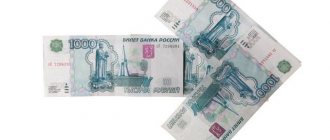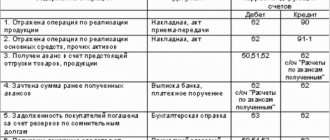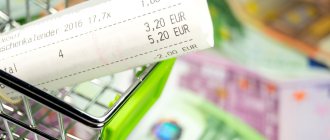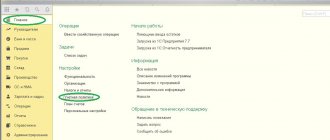Distribution of VAT for separate accounting
Value added tax amounts presented by suppliers of goods, works, and services must either be deducted (in taxable transactions) or included in the cost of goods and services for calculating income tax (in tax-exempt transactions).
This is indicated in paragraph 4 of Art. 170 Tax Code of the Russian Federation. Moreover, if a company does not maintain separate accounting for VAT, but carries out taxable and tax-exempt activities, then it cannot apply the right to deduct input VAT, nor increase the cost of products by the tax amount (paragraph 6, paragraph 4, article 170 of the Tax Code RF). The same is stated in the letter of the Ministry of Finance dated November 11, 2009 No. 03-07-11/296. The courts also agree with this, as evidenced by the established judicial practice of refusing taxpayers’ claims if they do not keep separate records of VAT (Resolution of the Federal Antimonopoly Service of the West Siberian District dated April 21, 2009 No. F04-2146/2009(4710-A27-19) , F04-2146/2009 (4321-A27-19) in case No. A27-10576/2008).
However, if goods, works, services are used only in relation to taxable transactions, then even in the absence of separate VAT accounting, the taxpayer has the right to exercise the right to deduct for them (letter of the Federal Tax Service dated 02.02.2007 No. ШТ-6-03 / [email protected] ).
ConsultantPlus experts explained the procedure for separate accounting of input VAT:
If you do not have access to the K+ system, get a trial online access for free.
How to apply the five percent rule for separate accounting of input VAT
Maintaining separate accounting is a mandatory requirement for organizations that carry out different types of value-added operations. When using the 5% rule, the company can deduct input fees for taxes that are immediately attributed to taxable and non-taxable procedures.
The purpose of maintaining separate tax records is the correct distribution of VAT to the budget. The Tax Code does not prescribe a methodology for separately recording data on deductions. Transactions can be recorded in subaccounts.
The duty to maintain is due to the fact that the tax must be taken into account using different methods. Input tax on products or services used for taxable transactions is refundable. If the activity is non-taxable, the payment is included in the cost of goods or services. There is also another category, if the company carries out two types of operations at once - then the fee is distributed.
It is possible not to distribute deductions only when, for ¼ of the year, the share of expenses for the purchase or sale of objects exempt from payment does not exceed 5%. This is what this rule is. If it is met, the input tax can be fully deducted without having to be distributed.
Increase in expenses in the amount of VAT
If the purchased goods (work, fixed assets, services, intangible assets or property rights) will be used only in tax-exempt activities (the list of such operations is specified in paragraphs 1–3 of Article 149 of the Tax Code of the Russian Federation), then the taxpayer has the right to increase their value by the amount of VAT for subsequent calculation of income tax. This is indicated in paragraph. 2 clause 4 art. 170 Tax Code of the Russian Federation.
The same applies to goods that are sold in a place not recognized as the territory of the Russian Federation.
Example No. 2
Materials were purchased in the amount of 131.11 rubles (VAT 20 rubles). VAT is marked for distribution. 3/4 of them (VAT 15 rubles) were written off. 1/4 (VAT 5 rubles) remained in the warehouse unused.
During the reporting period, goods were sold for 80 rubles with VAT and for 20 rubles without VAT.
Please note that VAT on written-off materials and those remaining in the warehouse is included in the “VAT Distribution” document on different lines. For the remaining materials, the cost account will be the same as the account for the materials themselves (for example, 10.01). Decommissioned ones have 20 or 26, depending on your settings.
In the document “Creating Purchase Ledger Entries” these lines are combined again.
Principles of maintaining separate VAT accounting
1. In one type of activity.
When purchasing goods and services that are entirely used in taxable activities, the taxpayer does not have any difficulties in displaying them in tax accounting. Thus, the buyer will be able to fully accept the VAT presented by the supplier for deduction on the basis of clause 1 of Art. 172 and paragraph 4 of Art. 170 Tax Code of the Russian Federation.
If the purchased goods are fully used in tax-exempt activities, then the entire amount of VAT will be attributed to the increase in their value.
2. In several types of activities.
In cases where the purchased goods, fixed assets (FPE), services, intangible assets (ITA), work or property rights will be used in both taxable and VAT-exempt activities, the distribution of VAT for separate accounting will be special. Then part of the tax presented by the supplier can be used as a deduction, and the other part can be used to increase the cost of the purchase.
In order to determine which amount of tax will be used as a deduction and which will go to increase the cost, it is necessary to calculate the proportion (paragraph 4, clause 4, article 170 of the Tax Code of the Russian Federation).
The taxpayer should make an entry about the received invoice in the purchase book only in that part that will be deducted (clause 2, subparagraph “y”, clause 6, clause 23(2) of the Rules for maintaining the purchase book, approved by decree of the Government of the Russian Federation dated December 26, 2011 No. 1137).
What is the procedure for distributing input VAT?
> > > 19 August 2021 The distribution of input VAT is made based on the proportion of taxable and non-taxable transactions. In this case, input VAT can either be deducted or included in the cost of goods, works or services (para.
4 p. 4 art. 170 of the Tax Code of the Russian Federation). The article discusses in detail the main provisions related to the distribution of input VAT.
The deductible VAT is calculated based on the following proportion: ST (with VAT) / ST (total), where ST (with VAT) is the cost of goods (work, services) shipped during the tax period, the sale of which is subject to VAT; ST (total) - the total (total) cost of goods (work, services) shipped in a given tax period.
VAT to be included in the cost of goods is calculated according to the following proportion: ST (without VAT) / ST (total), where ST (without VAT) is the cost of goods (work, services) shipped in the tax period, the sale of which is not subject to VAT; ST (total) - the total (total) cost of goods (work, services) shipped in a given tax period. How to calculate the proportion if the shipping cost has changed, read.
During the 3rd quarter of 2021, the company shipped goods, of which:
- products subject to VAT in the amount of 120,000 rubles;
- products not subject to VAT in the amount of 60,000 rubles.
There were no other sales of works, services or other property rights in this tax period.
The total cost of goods sold was 120,000 + 60,000 = 180,000 rubles. The amount of input VAT for the tax period is 145,000 rubles.
To distribute input VAT, a proportion must be drawn up. 1. The share of tax accepted for deduction is: 120,000 / 180,000 = 0.67; Therefore, the tax amount will be 145,000 * 0.67 = 97,150 rubles. 2. The share of tax included in the cost of purchased goods: 60,000 / 180,000 = 0.33; Therefore, the tax amount will be 145,000 * 0.33 = 47,850 rubles.
A number of revenues are legally defined, which
Features of calculating proportions for separate VAT accounting
1. Tax period.
The proportion is determined based on data from the tax period, which is a quarter (letters from the Ministry of Finance dated November 12, 2008 No. 03-07-07/121 and the Federal Tax Service dated May 27, 2009 No. 3-1-11 / [email protected] ). The VAT received from the supplier should be distributed in the tax period when the goods were accepted for registration (letter of the Ministry of Finance dated October 18, 2007 No. 03-07-15/159).
The exception is fixed assets and intangible assets that were registered in the first or second month of the quarter. The taxpayer has the right to distribute VAT in accordance with the proportion on these assets based on the results of the month when they were reflected in accounting in connection with their acceptance (subclause 1, clause 4.1, article 170 of the Tax Code of the Russian Federation).
In addition, special rules when calculating proportions apply to:
- operations with financial instruments of futures transactions (subclause 2, clause 4.1, article 170 of the Tax Code of the Russian Federation);
- clearing operations (subclause 3, clause 4.1, article 170 of the Tax Code of the Russian Federation);
- operations to provide a loan in securities or money, REPO operations (subclause 4, clause 4.1, article 170 of the Tax Code of the Russian Federation) or the sale of securities (subclause 5, clause 4.1, article 170 of the Tax Code of the Russian Federation).
2. Formula.
In order to understand how separate VAT accounting is carried out, you should familiarize yourself with the following formulas:
PNDS = SNDS / Commun.
where PVT – proportional VAT to be deducted;
SNDS – the total value of revenue for goods shipped as part of taxable transactions;
Total – the total amount of goods shipped during the reporting period.
VAT = Sneobl / Commun.
VAT – the amount of VAT allocated to increase the cost of goods;
Sneobl - the cost of goods shipped as part of tax-exempt transactions;
Total – the total amount of goods shipped during the reporting period.
See also the material “It is explained how to calculate the proportion for separate accounting if there has been a sale of securities .
The above formulas are derived on the basis of the norms contained in clause 4.1 of Art. 170 Tax Code of the Russian Federation. In this case, when calculating the proportion, one should not take into account those receipts that cannot be recognized as revenue from the sale of goods. This:
- interest on deposits (letter of the Ministry of Finance dated March 17, 2010 No. 03-07-11/64);
- dividends on shares (letter of the Ministry of Finance of Russia dated March 17, 2010 No. 03-07-11/64);
- discounts on bills (letter of the Ministry of Finance of Russia dated March 17, 2010 No. 03-07-11/64);
- amounts received in the form of penalties associated with changes in loan terms (letter of the Ministry of Finance dated July 19, 2012 No. 03-07-08/188);
- financing received by the division from the parent company (Resolution of the Presidium of the Supreme Arbitration Court of the Russian Federation dated July 30, 2012 No. 2037/12);
- transactions of issuers of depositary receipts of Russia for the placement of these receipts, as well as for the purchase and sale of securities related to receipts (paragraph 8, clause 4, article 170 of the Tax Code of the Russian Federation).
When calculating the total amount of goods shipped for the reporting period, sales should be taken into account both in Russia and abroad (determination of the Supreme Arbitration Court of the Russian Federation dated June 30, 2008 No. 6529/08).
It is impossible to use other formulas to calculate proportions - for example, based on the area of premises used for taxable and tax-exempt activities (Resolution of the Federal Antimonopoly Service of the East Siberian District dated March 20, 2009 No. A33-7683/08-F02-959/09) .
3. Amount excluding VAT.
To calculate the proportion, it is necessary to take the cost of shipped goods excluding VAT (letter of the Ministry of Finance dated August 18, 2009 No. 03-07-11/208, Federal Tax Service of Russia dated March 21, 2011 No. KE-4-3/4414). It is necessary to take into account that the established judicial practice fully supports the conclusions of the financial department and controllers.
Officials, the Presidium of the Supreme Arbitration Court of the Russian Federation and lower arbitration courts justify their decisions by the fact that separate accounting for VAT should be in comparable values. Moreover, when calculating both VAT-taxable and non-taxable transactions.
At the same time, some judges do not see in Art. 170 of the Tax Code directly indicates that when calculating the proportion, the amount of VAT must be excluded, and decisions are made in favor of taxpayers who do not agree with the position expressed above.
Do I need to submit documents confirming separate accounting?
The Tax Code (Articles 165, 172 of the Tax Code of the Russian Federation) does not contain requirements to submit to tax inspectors, along with the declaration, documents confirming the maintenance of separate accounting, so taxpayers are not required to do this. Judicial practice has also developed in favor of taxpayers: such, for example, is the decision of the Federal Antimonopoly Service of the Moscow District in resolution No. KA-A41/7691-10 dated July 20, 2010 in case No. A41-20286/07. Also, taxpayers do not have to submit these documents during a desk audit (Articles 88, 93 of the Tax Code of the Russian Federation).
At the same time, the very requirement of tax officials to provide documents - evidence of maintaining separate records is unlawful (resolution of the Federal Antimonopoly Service of the Moscow District dated October 7, 2008 No. KA-A40/8592-08 in case No. A40-9998/08-151-31, dated September 11. 2008 No. KA-A40/6520-08 in case No. A40-51243/07-112-285).
Methodology for separate VAT accounting
In ch. 21 of the Tax Code of the Russian Federation does not prescribe the methodology for separate VAT accounting, so taxpayers determine it independently. In practice, enterprises consolidate methodological recommendations for separate VAT accounting in their accounting policies.
If an enterprise actually uses separate accounting for VAT, but this is not reflected in the rules for its maintenance in the accounting policy, then it is possible to challenge the likely denial of the tax authorities’ right to deduction in court. In this case, it is only necessary to provide evidence that such a division is carried out when accounting for VAT.
However, there is also negative judicial practice for taxpayers who could not prove that separate accounting is maintained (Resolution of the Federal Antimonopoly Service of the Far Eastern District dated July 20, 2011 No. F03-2961/2011). Therefore, you should not ignore the reflection of the rules of separate accounting in the accounting policy.
For information on what to do if there was no shipment in a certain period, see the material “Separate accounting of VAT in non-income periods is carried out according to the taxpayer’s rules .
What documents confirm separate accounting
Since the Tax Code of the Russian Federation does not list the documents that confirm the maintenance of separate accounting, the organization independently decides for itself how to confirm such accounting. Such documents, for example, include:
- order to maintain separate accounting and accounting registers (resolution of the Federal Antimonopoly Service of the Moscow District dated January 15, 2008 No. KA-A40/14151-07 in case No. A40-73755/06-14-434);
- certificate of VAT calculation (resolution of the Federal Antimonopoly Service of the Moscow District dated January 10, 2008 No. KA-A40/13822-07 in case No. A40-15201/07-107-32, dated December 13, 2005 No. KA-A40/12261-05-P, dated 06.12.2005 No. KA-A40/11142);
- order on accounting policy, working chart of accounts of the enterprise with a transcript, journal for account 19 (resolution of the Federal Antimonopoly Service of the Moscow District dated January 09, 2008 No. KA-A40/13748-07 in case No. A41-K2-4864/07);
- accounting certificate on the calculation of “input” VAT for the month in which there were export supplies (resolution of the Federal Antimonopoly Service of the Moscow District dated July 19, 2007, July 25, 2007 No. KA-A40/6810-07-P in case No. A40-27650/06-129- 203);
- accounting policies and methods of separate accounting (resolutions of the Federal Antimonopoly Service of the Moscow District dated 07/18/2006, 07/24/2006 No. KA-A40/5958-06-B in case No. A40-50592/05-87-430, dated 01/19/2006, 01/16/2006 No. KA-A40/13686-05);
- order of the head of the organization on maintaining separate accounting and calculation of VAT by the accounting department (resolution of the Federal Antimonopoly Service of the Volga Region dated April 25, 2006 in case No. A55-9050/2005-22);
- balance sheets and explanatory note on maintaining separate VAT accounting for general business transactions (resolution of the Federal Antimonopoly Service of the Moscow District dated 04/03/2006, 03/30/2006 No. KA-A40/2399-06 in case No. A40-43375/05-107-342);
- purchase books and sales books (resolutions of the Federal Antimonopoly Service of the North-Western District dated 02/16/2006 No. A52-4203/2005/2, dated 09/09/2005 No. A56-46648/04);
- balance sheets (resolutions of the FAS Moscow District dated January 31, 2006, January 30, 2006 No. KA-A40/62-06 in case No. A40-39222/05-128-333, FAS Moscow District dated August 11, 2005 No. KA-A40/ 7422-05);
- accounting policy and calculation of the amount of VAT (resolution of the Federal Antimonopoly Service of the Moscow District dated September 15, 2005 No. KA-A40/8454-05-P);
- balance sheets and methods of maintaining separate accounting (resolution of the Federal Antimonopoly Service of the Moscow District dated 08/11/2005, 08/08/2005 No. KA-A40/7513-05);
- accounting policy (resolution of the Federal Antimonopoly Service of the Moscow District dated 01.08.2005 No. KA-A40/7107-05);
- accounting certificate (resolution of the Federal Antimonopoly Service of the Ural District dated 08/23/2005, 08/22/2005 No. F09-493/05-S2).
How to maintain separate VAT accounting: postings
It is necessary to open second-order subaccounts to account for VAT received from suppliers. Thus, subaccount 19-1 will collect VAT on goods (services, fixed assets, intangible assets) that are used in both types of activities. 19-2 proposes to accumulate VAT on goods that will be used in taxable activities. Subaccount 19-3 will take into account VAT, which will subsequently increase the cost of goods used in tax-exempt activities.
Example of postings when capitalizing a fixed asset:
May
Dt 08 Kt 60 (equipment accepted from the supplier) - 60,000 rubles.
Dt 19-1 Kt 60 (input VAT included) - 10,800 rubles.
Dt 60 Kt 51 (money transferred to the supplier) - 70,800 rubles.
Dt 01 Kt 08 (equipment accepted for registration) - 60,000 rubles.
June
Dt 44 Kt 02 (depreciation is calculated using the straight-line method, the useful life of the equipment is 4 years) - 1,250 rubles.
March
Dt 19-2 Kt 19-1 (VAT, which will be used as a deduction) - 7,000 rubles.
Dt 19-3 Kt 19-1 (the amount of VAT that will go to increase the cost of equipment) - 3,000 rubles.
Dt 68 Kt 19-2 (VAT accepted for deduction) - 7,000 rubles.
Dt 01 Kt 19-3 (increase in the book value of equipment) - 3,000 rubles.
Dt 44 Kt 02 (additional depreciation for June) - 62.5 rubles.
Dt 44 Kt 02 (depreciation for July) - 1,131.25 rubles.
When is it possible not to maintain separate VAT accounting?
Sometimes situations may arise when a taxpayer carries out taxable and tax-exempt transactions, but he does not have the obligation to maintain separate VAT records.
1. The 5% rule.
Until 2021, taxpayers could not keep separate tax records in those tax periods when the total expenses for operations exempt from VAT (not subject to VAT) are less than or equal to 5% of the total value of all expenses for the production process. During these periods, all amounts of VAT claimed by suppliers were subject to deduction in full. Since 2021, maintaining separate records has become mandatory in such periods. At the same time, the opportunity to deduct the entire tax in them remained.
It is important to remember that when calculating indicators, it is the costs of conducting non-taxable transactions that are used, and not the revenue from such activities (letter of the Ministry of Finance dated September 8, 2011 No. 03-07-11/241). At the same time, when calculating the 5% barrier, expenses for all VAT-free transactions are taken into account, and not for just one (letter of the Federal Tax Service dated August 3, 2012 No. ED-4-3 / [email protected] ).
2. Other cases.
The courts also recognize the right of taxpayers not to keep separate records:
- if the goods were immediately purchased for purposes not subject to VAT, but subsequently their purpose was changed (determination of the Supreme Arbitration Court of the Russian Federation dated June 26, 2008 No. 8277/08);
- if promissory notes of third parties are presented for redemption, taking into account the fact that the main activity subject to VAT is also carried out.
In this case, the Federal Antimonopoly Service of the Moscow District sided with the taxpayer, indicating that he should not keep separate records, since neither general administrative nor production expenses can be included in the costs of purchasing bills of exchange. In addition, in paragraph 4 of Art. 170 of the Tax Code of the Russian Federation does not mention transactions related to the circulation of securities - only commodity transactions (Resolution of the Federal Antimonopoly Service of the Moscow District dated September 23, 2009 No. KA-A40/9481-09).
Borrowing operations and separate accounting
Providing loans, selling securities and other similar transactions are subject to VAT. A significant nuance in calculating the proportion for such operations is the indicator of income amounts, which is key in the formula. For operations of one type or another, it will have a different composition, which is influenced by the current provisions of federal legislation. Federal Law No. 420 of December 28, 2013 proposes that for transactions with securities not subject to VAT, the following amount should be considered income:
D = Tsr – Rpr , where:
- D – tax-free income;
- CR – selling price of securities (according to the provisions of Article 280 of the Tax Code of the Russian Federation);
- Ррр – expenses for the acquisition of these securities (and/or sale).
If the difference is less than 0 (that is, there will be a loss), then the income is not taken into account.
The proportional calculation method for separating taxable and non-taxable transactions in this situation involves calculating the ratio between the cost of all goods sold (both in Russia and abroad) and the item of interest. The amount of income will also include:
- the entity's revenue;
- the cost of its fixed assets;
- his non-operating income.
Currently, there is no consensus on the need to maintain separate accounting for borrowing transactions. However, the Ministry of Finance of the Russian Federation is increasingly inclined to this position due to the introduction of significant changes to the Tax Code of the Russian Federation.
Results
The obligation to maintain separate accounting requirements for VAT suppliers arises if the taxpayer carries out both taxable and non-taxable activities. The conditions and principles for maintaining such records are specified in paragraphs. 4 and 4.1 art. 170 of the Tax Code of the Russian Federation, but taxpayers determine its methodology independently.
If an enterprise purchases materials, goods or services that will subsequently be used for both activities, then the proportion according to which the input VAT will be divided should be calculated.
In this case, part of the tax will be used as a deduction when accounting for transactions subject to VAT, and the other share will go to increase the value of assets that were used in transactions not subject to VAT. You can find more complete information on the topic in ConsultantPlus. Free trial access to the system for 2 days.
How to calculate the proportion for the distribution of tax amounts
In accordance with paragraph 4 of Article 170 of the Tax Code, input VAT on goods, works and services used to carry out taxable and non-taxable VAT transactions is taken for deduction (taken into account in the cost) in proportion to the volume of their use for the production and sale of goods and services, subject to and non-taxable VAT .
In this case, the proportion is calculated based on the ratio of the cost of goods shipped, both subject and not subject to taxation, to the total cost of goods shipped for the period. This rule is established in paragraph 4.1 of Article 170 of the Tax Code of the Russian Federation. Please note that this paragraph contains some features of compiling the indicated proportion.
The result is a fractional expression as a percentage, where the numerator is tax-free sales revenue, and the denominator is the total amount of sales revenue. This is the share of VAT on non-taxable transactions . The share of VAT subject to deduction is determined by the formula: 100 - the share of VAT on non-taxable transactions.









